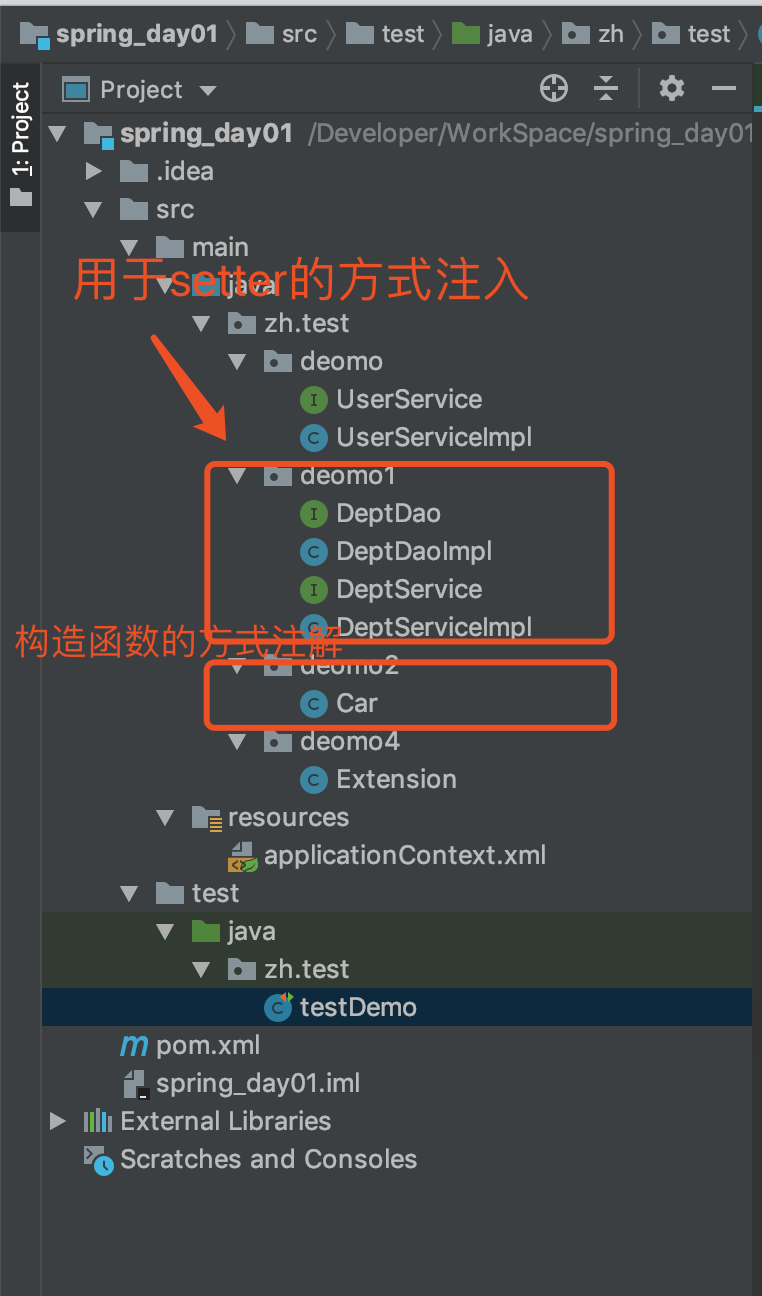目的:了解spring框架中的注解
前言:同样是使用idea创建一个普通的maven工程(如何创建一个普通的Maven工程可以参考mybatis入门第一天的详解)。
项目结构:

代码编辑:
在项目中引入需要的Maven开发坐标
1 <dependencies> 2 <dependency> 3 <groupId>org.springframework</groupId> 4 <artifactId>spring-context</artifactId> 5 <version>5.0.2.RELEASE</version> 6 </dependency> 7 <dependency> 8 <groupId>commons-logging</groupId> 9 <artifactId>commons-logging</artifactId> 10 <version>1.2</version> 11 </dependency> 12 <dependency> 13 <groupId>log4j</groupId> 14 <artifactId>log4j</artifactId> 15 <version>1.2.12</version> 16 </dependency> 17 <dependency> 18 <groupId>junit</groupId> 19 <artifactId>junit</artifactId> 20 <version>4.12</version> 21 <scope>test</scope> 22 </dependency> 23 </dependencies>
- 在demo文件下 编写接口UserService
1 package zh.test.deomo; 2 3 public interface UserService { 4 public void sayHi(); 5 }
- 实现接口,编写UserServiceImpl
1 package zh.test.deomo; 2 3 public class UserServiceImpl implements UserService { 4 5 public void sayHi() { 6 System.out.println("SayHi"); 7 } 8 }
- 载demo1文件下,编写关于spring使用setter的方式注入
创建一个DeptDao的接口
1 package zh.test.deomo1; 2 3 public interface DeptDao { 4 public void save(); 5 }
实现该接口,DeptDaoImpl
1 package zh.test.deomo1; 2 3 public class DeptDaoImpl implements DeptDao { 4 public void save() { 5 System.out.println("持久层。。保存。。。"); 6 } 7 }
编写DeptService的接口
1 package zh.test.deomo1; 2 3 public interface DeptService { 4 public void save(); 5 }
实现接口DeptServiceImpl
1 package zh.test.deomo1; 2 3 public class DeptServiceImpl implements DeptService { 4 private DeptDao deptDao; 5 6 //普通的数据类型,也需要提供set的方法注入 7 private String name; 8 private int age; 9 10 public void setName(String name) { 11 this.name = name; 12 } 13 14 public void setAge(int age) { 15 this.age = age; 16 } 17 18 //依赖注入通过set的方法传递进来 19 public void setDeptDao(DeptDao deptDao) { 20 System.out.println("set被调用。。。"); 21 this.deptDao = deptDao; 22 } 23 24 public void save() { 25 System.out.println("业务层。。。保存"); 26 System.out.println(name+":"+age); 27 deptDao.save(); 28 } 29 }
- 在deomo2的文件下编写关于使用构造函数的方式注入Car.java文件
1 package zh.test.deomo2; 2 3 public class Car { 4 private String name; 5 private Double money; 6 7 public String getName() { 8 return name; 9 } 10 11 public void setName(String name) { 12 this.name = name; 13 } 14 15 public Double getMoney() { 16 return money; 17 } 18 19 public void setMoney(Double money) { 20 this.money = money; 21 } 22 23 @Override 24 public String toString() { 25 return "Car{" + 26 "name='" + name + '\'' + 27 ", money=" + money + 28 '}'; 29 } 30 31 public Car(String name, Double money) { 32 this.name = name; 33 this.money = money; 34 } 35 }
- 在deomo4文件下编写扩展的类,主要是存放集合、数组、属性文件
1 package zh.test.deomo4; 2 3 4 import java.util.Arrays; 5 import java.util.List; 6 import java.util.Map; 7 import java.util.Properties; 8 9 public class Extension { 10 //数组 11 private String [] strs; 12 13 //集合 14 private List<String> list; 15 16 //map 17 private Map<String,String> map; 18 19 //属性文件 20 private Properties properties; 21 22 @Override 23 public String toString() { 24 return "Extension{" + 25 "strs=" + Arrays.toString(strs) + 26 ", list=" + list + 27 ", map=" + map + 28 ", properties=" + properties + 29 '}'; 30 } 31 32 public String[] getStrs() { 33 return strs; 34 } 35 36 public void setStrs(String[] strs) { 37 this.strs = strs; 38 } 39 40 public List<String> getList() { 41 return list; 42 } 43 44 public void setList(List<String> list) { 45 this.list = list; 46 } 47 48 public Map<String, String> getMap() { 49 return map; 50 } 51 52 public void setMap(Map<String, String> map) { 53 this.map = map; 54 } 55 56 public Properties getProperties() { 57 return properties; 58 } 59 60 public void setProperties(Properties properties) { 61 this.properties = properties; 62 } 63 }
- 编写applicationContxt.xml文件在resources目录下
1 <?xml version="1.0" encoding="UTF-8"?> 2 <beans xmlns="http://www.springframework.org/schema/beans" 3 xmlns:xsi="http://www.w3.org/2001/XMLSchema-instance" xmlns:util="http://www.springframework.org/schema/util" 4 xsi:schemaLocation="http://www.springframework.org/schema/beans 5 http://www.springframework.org/schema/beans/spring-beans.xsd http://www.springframework.org/schema/util http://www.springframework.org/schema/util/spring-util.xsd"> 6 7 <!--IOC管理bean--> 8 <!--配置实现类,配置组建bean管理--> 9 <!-- 10 标签bean 用来管理类,把类交给IOC容器管理,IOC容器把当前的这个类创建对象,存入到IOC容器中。 11 id="唯一的值,自定义" 12 class="管理类的全路径,包名+类名 底层使用反射代码创建对象" 13 class.forName("zh.test.deomo.UserServiceImpl") 14 15 16 scope="是创建之后的对象是单例的还是多例的" 默认是单例的 17 scope="singleton" 单例的 18 scope="prototype" 多例的 19 区别:如果是多例的在程序加载配置文件的时候不会立即创建一个对象,而是什么时候用到什么时候会用到。 20 如果是单例的则是在程序已加载的时候就会创建一个对象。只要IOC的容器存在那么单例的对象就一直存在。 21 --> 22 <bean id="userService" class="zh.test.deomo.UserServiceImpl" /> 23 24 <!--通过set的方法注入--> 25 <bean id="deptService" class="zh.test.deomo1.DeptServiceImpl"> 26 <!--依赖注入 name="service中的属性"--> 27 <property name="deptDao" ref="deptDao"/> 28 <!--给普通的属性注入值--> 29 <property name="name" value="白天黑天阴天"/> 30 <property name="age" value="20"/> 31 </bean> 32 <bean id="deptDao" class="zh.test.deomo1.DeptDaoImpl"></bean> 33 34 <!--属性的构造方法--> 35 <bean id="car" class="zh.test.deomo2.Car"> 36 <constructor-arg name="name" value="劳斯劳斯"/> 37 <constructor-arg name="money" value="11111"/> 38 </bean> 39 40 <!--扩展方法--> 41 <bean id="extension" class="zh.test.deomo4.Extension"> 42 <!--数组--> 43 <property name="strs"> 44 <array> 45 <value>l</value> 46 <value>g</value> 47 </array> 48 </property> 49 50 <!--集合--> 51 <property name="list"> 52 <list> 53 <value>james</value> 54 <value>davis</value> 55 </list> 56 </property> 57 58 <!--map--> 59 <property name="map"> 60 <map> 61 <entry key="lakers" value="lebron"/> 62 <entry key="lakers1" value="davis"/> 63 </map> 64 </property> 65 66 <!--属性文件--> 67 <property name="properties"> 68 <props> 69 <prop key="lakers">london</prop> 70 <prop key="lakers1">kuzma</prop> 71 </props> 72 </property> 73 </bean> 74 </beans>
- 最后写一个测试的方法,对以上的注入进行测试
1 package zh.test; 2 3 import org.junit.Test; 4 import org.springframework.context.ApplicationContext; 5 import org.springframework.context.support.ClassPathXmlApplicationContext; 6 import zh.test.deomo.UserService; 7 import zh.test.deomo.UserServiceImpl; 8 import zh.test.deomo1.DeptService; 9 import zh.test.deomo2.Car; 10 import zh.test.deomo4.Extension; 11 12 public class testDemo { 13 @Test 14 public void test() 15 { 16 //原始写法: 17 UserServiceImpl userService = new UserServiceImpl(); 18 userService.sayHi(); 19 //使用Spring框架 20 21 } 22 23 @Test 24 public void testSpring(){ 25 //创建SpringIOC的工厂(容器) ,需要加载配置文件,就会将配置文件中的类通过反射的方式创建成对象 26 //将对象存入到容器中,以key : value 的方式,k="userService" v="UserServiceImpl对象(默认是单例的)" 27 // 28 ApplicationContext ac=new ClassPathXmlApplicationContext("applicationContext.xml"); 29 //从容器中获取对象 面向接口的编程 30 UserService userService = (UserService) ac.getBean("userService"); 31 //调用对象 32 userService.sayHi(); 33 } 34 35 // setter的方式注入 36 @Test 37 public void testSpringDI(){ 38 //创建SpringIOC的工厂(容器) ,需要加载配置文件,就会将配置文件中的类通过反射的方式创建成对象 39 //将对象存入到容器中,以key : value 的方式,k="userService" v="UserServiceImpl对象(默认是单例的)" 40 // 41 ApplicationContext ac=new ClassPathXmlApplicationContext("applicationContext.xml"); 42 //从容器中获取对象 面向接口的编程 43 DeptService deptService = (DeptService) ac.getBean("deptService"); 44 //调用对象 45 deptService.save(); 46 } 47 48 // 属性的构造方法注入 49 @Test 50 public void testCar(){ 51 ApplicationContext ac=new ClassPathXmlApplicationContext("applicationContext.xml"); 52 //从容器中获取对象 面向接口的编程 53 Car car = (Car) ac.getBean("car"); 54 //调用对象 55 System.out.println(car); 56 } 57 58 //扩展方法 数组、集合、map、属性文件 59 @Test 60 public void testExtension(){ 61 ApplicationContext ac=new ClassPathXmlApplicationContext("applicationContext.xml"); 62 //从容器中获取对象 面向接口的编程 63 Extension extension = (Extension) ac.getBean("extension"); 64 //调用对象 65 System.out.println(extension); 66 } 67 68 }
分享之路,欢迎交流。。。